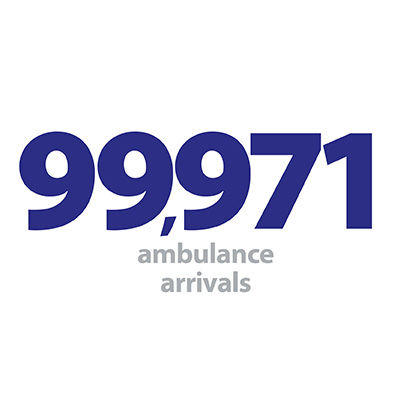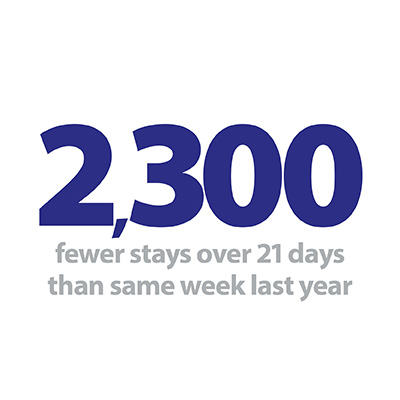


This week NHS England published the combined performance summary alongside the winter sitreps, giving us a broader picture of how the NHS is managing this winter.
The winter sitreps data continues to reflect the trend of increasing demand, with bed occupancy reaching another new high for this winter and ambulance arrivals hitting the second highest total on record. Length of stay remains one of the positive stories of the season so far, and there was a welcome reduction in beds closed with diarrhoea and vomiting and norovirus since the spike last week. As demonstrated in the monthly combined performance summary released today, urgent and emergency care services are experiencing exceptional pressure, with large increases in A&E attendances and admissions compared to the same point last year and performance against the four-hour target slipping to 84.4% - its worst recorded level.
Urgent and emergency care services are experiencing exceptional pressure, with large increases in A&E attendances and admissions compared to the same point last year and performance against the four-hour target slipping to 84.4% - its worst recorded level.
Key indicators in the week 10 sitreps include:
- Bed occupancy rose again this week by 0.3% and now sits at 95.2%, a new high for this winter and equal to the highest seen last year.
- 132 more escalation beds were opened since last week, with the total of 4,015, also the highest of the winter so far. However, this remains 14.6% lower than the peak last year.
- The number of total beds open (98,030) was very similar to last week, and is also virtually the same as at the same point last year.
- Length of stay data was impressive this week, with those staying longer than 7 days, 14 days and 21 days all down from last week and considerable lower than the same point last year where there is comparable data.
- Beds closed with diarrhoea and vomiting and norovirus reduced by 7.9% this week to 653, the second highest figure this winter but 20% lower than at the same point last year.
- There were 25 A&E diverts this week, almost double last week’s total of 13.
- Ambulance arrivals increased by 2.4% this week to 99,971, the second highest figure of this winter and 7.6% higher than last year. This is over a thousand extra arrivals each day compared to the same point in 2017/18.
- Handover delays increased since last week, with the number of arrivals waiting more than 30 minutes up by 1.3% to 13.5%, and the number waiting more than 60 minutes up by 0.4% to 3.1%, both the highest of the winter so far.
- A&E closures – 0
- Adult critical care bed occupancy was similar to last week at 85.7%. Paediatric intensive care bed occupancy decreased by 1.5% this week to 79.4%. Neonatal intensive care bed occupancy decreased this week by 0.3% to 68.8%.
Trusts around the country are managing extremely high bed occupancy with 43 trusts (out of 134 with an A&E department) reaching 95% bed occupancy on every day of the last week.
Trusts around the country are managing extremely high bed occupancy with 43 trusts (out of 134 with an A&E department) reaching 95% bed occupancy on every day of the last week. The overall occupancy figure of 95.2% is the highest of this winter so far, and equals the peak recorded last year. The number of escalation beds open increased by a small amount this week, also reaching a new high for this winter – but almost 700 fewer than the peak last year. This may suggest that some trusts still have capacity to call upon, but it is equally possible that efforts to improve patient flow have already re-allocated this - for example, by creating space for ambulatory care treatment areas.
Another reason for additional pressure this week was a jump in ambulance arrivals, up by 2.4% to 99,971, a weekly total surpassed only once since the data was collected. This is 7.6% higher than a year ago, equivalent to one thousand extra arrivals per day. Handover delays suffered under the additional activity this week, with 13.5% of arrivals delayed by more than 30 minutes across the week, an increase of 1.3% since last week. This was most pronounced on Monday 4 February when 16.8% of ambulance arrivals were delayed by 30 minutes or more, but this measure improved through the week and by Sunday 10 February just 12.5% were delayed by 30 minutes or more.
In week nine we saw an ominous rise in the number of beds closed with D&V and norovirus, but this week the total fell back by 7.9%. 50 trusts remain affected nationwide, and while the north region has the largest number of beds closed, the south east has the highest proportion closed with 1.4% of its beds closed this week.
Another reason for additional pressure this week was a jump in ambulance arrivals, up by 2.4% to 99,971, a weekly total surpassed only once since the data was collected.
Significant efforts have been made to reduce the amount of time patients are spending in hospital, and we’ve heard from a number of trusts this winter in our member blogs about local innovations adopted to improve patient flow. Nationally, the length of stay data was impressive this week, with fewer patients staying longer than 7, 14 and 21 days compared to the previous week. Looking back to a year ago, there are now 5.9% fewer patients staying longer than 7 days, and 12.9% fewer staying longer than 21 days, a reduction of 2,300 patients. You can see our full analysis in our weekly summary dashboard.
This week Richard Jenkins, chief executive at Barnsley Hospital NHS Foundation Trust, outlines the steps they have taken to redesign their emergency care pathway following the difficult winter they experienced in 2017/18. While demand for urgent and emergency care services has never been higher, the trust has managed to maintain performance through improved staff engagement and with the support of partner organisations within the local health system. For the most part, the experience of the trust reflects the trend we have been seeing in the national data.
From the frontline: Barnsley Hospital NHS Foundation Trust
Rather perversely, we had been looking forward to winter this year as we have spent the last year overhauling and redesigning our whole approach to the emergency care pathway and winter preparedness and we wanted to see how we would cope when Winter arrived. The improvement work was extensive and ranged from restructuring the executive team portfolios to minor tweaks to how the emergency department hand over patients to the admission units. Our drive to do better this year came from the poor experience our patients and staff had in December and January last winter and a sense of 'never again'.
We put together a systematic programme with eight major components and high quality programme management. An important part of the work was 'hearts and minds' – we held lots of open meetings with staff to talk through some of the key proposed work and why we were doing it. In particular, a lot of time was spent with ED nurses who take the brunt of pressures. We were supported in the work by our partners in Barnsley (South West Yorkshire Partnership NHS Foundation Trust, Barnsley MBC, the local GP federation and Barnsley Clinical Commissioning Group) and the Improvement Academy.
Our drive to do better this year came from the poor experience our patients and staff had in December and January last winter and a sense of 'never again'.
Chief executive, Barnsley Hospital NHS Foundation Trust
So how did we do? We saw a progressive improvement in four-hour performance through the first half of 2018 with delivery of the 95% standard achieved in June. July was tough but everything seemed to click in August and we went 45 consecutive days over 95% culminating in having the best performance in the country for September. We maintained delivery of the standard through to Christmas.
Winter arrived later than expected this year in Barnsley. December went well with pressure really starting from 27 December. We were hit by a rebound of activity after the Christmas lull and it’s been tough since then. Despite that we are pleased with how our improved systems and processes have held up. Flu had a clear impact on us from mid January with significant pressure on our level 3 critical care capacity and the colder weather has led to some extremely busy days. When I joined the trust four years ago, our average daily emergency department attendances were 210 with activity very rarely hitting 300. We’ve now had two periods of four consecutive days over 300 attendances and three of our busiest ever days have been in the last fortnight. In the last year alone, we’ve seen a 12% rise in ED activity compared with the previous year.
We were hit by a rebound of activity after the Christmas lull and it’s been tough since then. Despite that we are pleased with how our improved systems and processes have held up.
Chief executive, Barnsley Hospital NHS Foundation Trust
We hit 95% in December but dropped to 91.1% in January. I’ve been really pleased to see the resilience of our staff when things have got difficult and I think staff recognise that, most of the time, we’ve been able to maintain flow and the pressure isn’t as relentless as usual. As I write this we’ve had some ups and downs with performance – last week we achieved 94% and then yesterday we experienced one of our worse days with performance in the mid 70s. It’s clear we need to keep working on our resilience and we will have a big focus this next year on ward processes to support flow.
Had we not done all the work through 2018, I’m not sure we would have coped with the pressures we’ve seen since Christmas. It feels better than previous winters but the pressure is not showing signs of letting up just yet.
Winter pressure putting significant strain on NHS trusts and staff
Responding to the latest monthly combined performance and weekly winter performance data from NHS England, NHS Providers director of policy and strategy Miriam Deakin said:
"The figures today show that demand for NHS care during winter has once again put significant strain on trusts and staff.
"The speed at which demand is increasing means that performance against the four-hour target in January has slipped to 84.4% - its worst recorded level. However the NHS treated an additional 75,670 patients within four hours compared to last year.
The figures today show that demand for NHS care during winter has once again put significant strain on trusts and staff.
Co-Director of Development and Engagementtweet this
"This is largely down to the work trusts have been doing to improve patient flow and reducing the time patients spend in hospital. Improved joined up working with partners in the community and primary care is also helping to support trusts to manage demand better.
"These pressures expand beyond emergency care. With bed occupancy currently sitting at the highest point of this winter, the ability of trusts to carry out planned operations has been impacted with more people waiting longer for routine surgery.
"But it is encouraging to see that despite wider pressures, trusts have begun to improve performance against key cancer targets and are now meeting the two-week urgent referral target.
"It is clear that NHS staff are continuing to work under severe pressure but will continue to pull out all stops to respond to winter pressures and provide high-quality care to those that need it most."